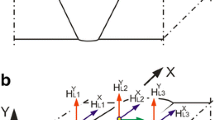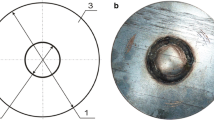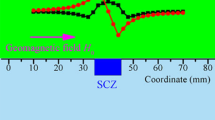Abstract
Metal magnetic memory(MMM) testing has been widely used to detect welded joints. However, load levels, environmental magnetic field, and measurement noises make the MMM data dispersive and bring difficulty to quantitative evaluation. In order to promote the development of quantitative MMM reliability assessment, a new MMM model is presented for welded joints. Steel Q235 welded specimens are tested along the longitudinal and horizontal lines by TSC-2M-8 instrument in the tensile fatigue experiments. The X-ray testing is carried out synchronously to verify the MMM results. It is found that MMM testing can detect the hidden crack earlier than X-ray testing. Moreover, the MMM gradient vector sum K vs is sensitive to the damage degree, especially at early and hidden damage stages. Considering the dispersion of MMM data, the K vs statistical law is investigated, which shows that K vs obeys Gaussian distribution. So K vs is the suitable MMM parameter to establish reliability model of welded joints. At last, the original quantitative MMM reliability model is first presented based on the improved stress strength interference theory. It is shown that the reliability degree R gradually decreases with the decreasing of the residual life ratio T, and the maximal error between prediction reliability degree R 1 and verification reliability degree R 2 is 9.15%. This presented method provides a novel tool of reliability testing and evaluating in practical engineering for welded joints.
Similar content being viewed by others
References
MIRCO C, LEANDRO J. Fatigue behavior prediction of welded joints by using an integrated fracture mechanics approach[J]. International Journal of Fatigue, 2012, 43: 43–53.
CONIGLIO N, CROSS C E. Initiation and growth mechanisms for weld solidification cracking[J]. International Materials Reviews, 2013, 58(7): 375–397.
DOUBOV A A. Detection of metallurgical and production defects in engineering components using metal magnetic memory[J]. Metallurgist, 2015, 59(1): 164–167.
KOLOKOLNIKOV S M, DOUBOV A A, MARCHENKOV Y A. Determination of mechanical properties of metal of welded joints by strength parameters in the stress concentration zones detected by the metal magnetic memory method[J]. Welding in the World, 2014, 58(5): 699–706.
REN Jilin, PAN Qianghua. Experimental research of magnetic memory testing on effect of stress on the magnetic domains[J]. Nondestructive Technology, 2010, 3: 157–159. (in Chinese)
WANG Huipeng, DONG Lihong, DONG Shiyun, et al. Fatigue damage evaluation by metal magnetic memory testing[J]. Journal of Central South University, 2014, 21(1): 65–70.
MACIEJ R. Metal magnetic memory testing of welded joints of ferritic and austenitic steels[J]. NDT & E International, 2011, 44(3): 305–310.
DOUBOV A, KOLOKOLNIKOV S. Application of the metal magnetic memory method for detection of defects at the initial stage of their development for prevention of failures of power engineering welded steel structures and steam turbine parts[J]. Welding in the World, 2014, 58(2): 225–236.
LIU Hongguang, ZHANG Weimin, MAO Xinyan, et al. Mult-parameter identification system of weld defects based on magnetic memory testing[J]. Manufacturing Automation, 2009, 31(2): 7–10. (in Chinese)
DI Xinjie, LI Wushen. Box dimension changes law of metal magnetic memory signal under tensile load[J]. Material Engineering, 2009, 5: 34–37. (in Chinese)
YI Fang, LI Zhuxin, LU Hongqing, et al. Defect recognition by metal magnetic memory detection of pipelines based on the fuzzy kernel function SVM[J]. Acta Petrolei Sinica, 2010, 31(5): 863–870. (in Chinese)
REN Jilin, SUN Jinli, ZHOU Pei, et al. Engineering Application prospect and research on magnetic memory in two-dimensional testing[J]. Journal of Mechanical Engineering, 2013, 49(22): 8–15. (in Chinese)
ZHOU Pei, REN Jilin, SUN Jinli, et al. Application of Lissajous figure in two-dimensional magnetic memory detection[J]. Acta Aeronautica et Astronautica Sinica, 2013, 34(8): 1990–1997. (in Chinese)
LIU Bin, FU Ying, JIAN Ren. Modelling and analysis of magnetic memory testing method based on the density functional theory[J]. Nondestructive Testing and Evaluation, 2015, 30(1): 13–25.
LENG Jiancheng, XU Minqiang, LI Jianwei, et al. Characterization of the elastic-plastic region based on magnetic memory effect[J]. Chinese Journal of Mechanical Engineering, 2010, 23(4): 532–536.
XING Haiyan, XU Minqiang, CHEN Xinyu, et al. Two kinds of welded joint typical defects comparison based on MMM characteristics[J]. Materials Science and Technology, 2011, 19(6): 65–69. (in Chinese)
QIN Ping. MMM defect degree quantification based on optimization algorithms[D]. Daqing: Northeast Petroleum University, 2014. (in Chinese)
XIA Changgao, ZHU Pei, ZHANG Meng, et al. Dispersion of the mechanical parts performance indicators based on the concept of random vector[J]. Chinese Journal of Mechanical Engineering, 2012, 25(1): 153–159.
MACIEJ R, BIENIEK M. Evaluation of residual stress in ferromagnetic steels based on residual magnetic field measurements[J]. NDT & E International, 2013, 45(1): 55–62.
HUANG Haihong, JIANG Shilin, Liu Rujun, et al. Investigation of magnetic memory signals induced by dynamic bending load in fatigue crack propagation process of structural steel[J]. Journal of Nondestructive Evaluation, 2014, 33(3): 407–412.
TSAI Y T, LIN K H, HSU Y Y. Reliability design optimization for practical applications based on modeling processes[J]. Journal of Engineering Design, 2013, 24(12): 849–863
LI Feng, MENG Guanwei, ZHOU Liming. Reliability for structures under complex load[J]. Journal of Harbin Institute of Technology, 2011, 42(1): 295–298. (in Chinese)
GANJI A, JOWKARSHORIJEH L. Advance first order second moment(AFOSM) method for single reservoir operation reliability analysis: a case study[J]. Stochastic Environmental Research and Risk Assessment, 2012, 26(1): 33–42.
GB/T 4885–2009, Lower confidence limit of reliability for complete sample from normal distribution[S]. Beijing: China Standard Publishing House, 2009. (in Chinese)
Author information
Authors and Affiliations
Corresponding author
Additional information
Supported by National Natural Science Foundation of China(Grant Nos. 11272084, 11472076), PetroChina Innovation Foundation(Grant No. 2015D-5006-0602), and Postdoctoral Science Research Developmental Foundation of Chinese Heilongjiang Province(Grant No. LBH-Q13035)
Biographical notes
XING Haiyan, born in 1971, is currently a professor at Northeast Petroleum University, China. She received her PhD degree from Harbin Institute of Technology, China, in 2007. Her research interests include nondestructive testing, reliability assessment and fault diagnosis.
DANG Yongbin, born in 1991, is currently a master candidate at Northeast Petroleum University, China
WANG Ben, born in 1985, is currently a master candidate at Northeast Petroleum University, China
LENG Jiancheng, born in 1977, is currently an associate professor at Northeast Petroleum University, China. He received his PhD degree from Harbin Institute of Technology, China, in 2012. His research interests include electromagnetic non-destructive evaluation.
Rights and permissions
About this article
Cite this article
Xing, H., Dang, Y., Wang, B. et al. Quantitative metal magnetic memory reliability modeling for welded joints. Chin. J. Mech. Eng. 29, 372–377 (2016). https://doi.org/10.3901/CJME.2015.1119.136
Received:
Revised:
Accepted:
Published:
Issue Date:
DOI: https://doi.org/10.3901/CJME.2015.1119.136




